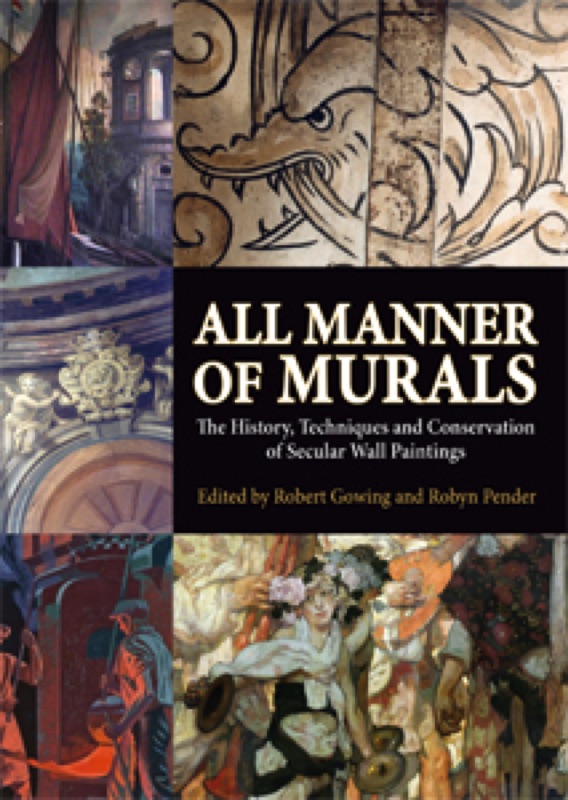Terrifying beasts, imaginary landscapes, portraits and ornaments - All Manner of Murals celebrates the many ways we have decorated our day-to-day lives with wall paintings. Murals by their very nature must remain in and on the structures for which they were designed, inextricably at one with their surroundings, and so offer glimpses of vanished ways of living. Whether painted in a humble cottage or a grand palace, they illustrate the march not only of history, but of our view of ourselves.
At once strange and strangely familiar, the ancient wall painting emerging from under layers of whitewash has much to tell us about how our predecessors saw the world around them. The tradition of wall painting, arguably the oldest of art forms, continues to this day, and our descendants may find our own values and views reflected in the murals, private and public, that we leave behind.
The 20 papers collected in this volume (from 3 symposia* hosted by the Stone and Wall Painting Group of the Institute of Conservation [ICON]) explore over 500 years of secular wall paintings, right up to contemporary work, looking at why and how they were painted, and the best ways of caring for them to ensure that future generations can also find in 'all manner of murals' a source of wonder and of kinship to their past.
*The 3 UKIC symposia were entitled:
Illusions of Grandeur: English Baroque wall paintings
Followers of Fashion: Renaissance wall paintings in Britain
Modern Traditions: 19th- and 20th-century secular wall paintings
For a look inside click here
List of Contributors
Foreword
Edward Impey and Alastair McCapra
Preface
Robert Gowing
Acknowledgements
Introduction: Designating the domestic - mural paintings and the Heritage Protection Review
Roger Bowdler
Part 1: History, development and care of secular wall paintings
Elusive sources for Renaissance wall paintings
Anthony Wells-Cole
Was there a Guise Palace in Edinburgh?
Michael Bath
Secular wall paintings in the Welsh Marches
Kathryn Davies
Pattern and colour in late 16th- and 17th-century secular wall and panel paintings in Suffolk: an overview
Andrea Kirkham
Changing rooms: changes in use and their impact on wall painting conservation
Tom Organ
Painted kings and painted gods (continental copy or English inspiration? The painted Baroque interior)
Giles Worsley
'The negligence of men' - restoration techniques and the altered appearance of Baroque wall paintings
Jane Davies
Mural paintings within the Historic Royal Palaces: our approach to their continuous care
Kate Frame and Sophie Julien-Lees
The art of the house painter: vernacular mural decoration c.1650-1841
James Ayres
Image and identity in mural painting in British public buildings, 1840-1940
Clare A. P. Willsdon
Contemporary mural painting: trends and traditions
Ernestine McKay
Part 2: Conservation and research case studies
The Catherine Room, Windsor Castle
Ann Ballantyne
Sixteenth-century wall paintings at the Forge, Much Hadham, Hertfordshire
Jane Rutherfoord
The public and private face of English Baroque wall painting: Milgate House, Kent and the Royal Hospital, Chelsea
Caroline Babington and Richard Pelter
Bedfordshire's Baroque masterpiece: the Thomas Archer Pavilion at Wrest Park
Stephen Paine and Sophie Stewart
The rediscovery of the lost ceiling decorations in the Saloon at Burlington House
Pauline Plummer and Peter Schmitt
The treatment of the Entrance Hall at the Fitzwilliam Museum, Cambridge: changing approaches to the conservation of 19th-century polychromy
Tobit Curteis
Tracking historic attitudes towards wall painting conservation: Lord Leighton's frescoes at the V&A
Robert Gowing
Rex Whistler: a comparative study of three decorative schemes
Marguerite O'Leary
More myth than mural: a study of the Hans Feibusch murals at South Civic Centre, Newport, South Wales
Kate Hunter and Elizabeth Holford
Reviews
All Manner of Murals illuminates the rich history of British secular wall painting with fascinating art-historical detail, new archival information and interpretations...All Manner of Murals makes a major contribution to highlighting the quality, diversity and vulnerability of secular wall paintings, surely the essential first step in their protection and care.
Studies in Conservation 54(1) (2009) 62-64
For anyone interested in the history, techniques and conservation of wall paintings, this lavishly illustrated scholarly book is essential reading. It not only captures the beauty and variety of images and motifs found in wall paintings, but also elucidates the influences and fashions which helped to create them while reminding us of their fragility and the need to conserve them for ourselves and future generations.
Journal of Architectural Conservation 13(3) (November 2007) 91-92
